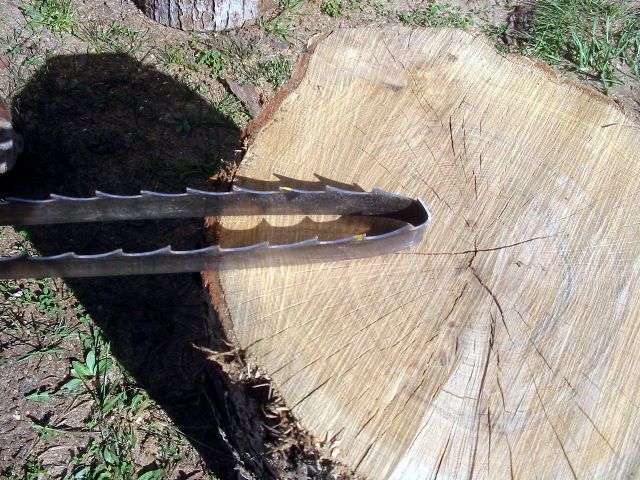Estimating Sawmill Overrun
Understanding the difference between the board feet estimated in a log and the board feet actually produced. May 11, 2005
Question
Here at the Tennessee Forest Products Center, I have had an enquiry about overrun for circle vs. bandmills. I would be very interested to hear some real numbers from people for their overrun (or underrun!) rates. Please indicate the mill type, log size, scale used and any other factor that you think is important. I won't be keeping track of names or places. I am especially interested in people with southern hardwood experience, but I welcome all comments.
Forum Responses
(Sawing and Drying Forum)
From contributor S:
We saw on a Wood-Mizer, mostly 12-16" ash, oak, locust, and hickory. We saw about 8000bf of 6/4 per month. Our average is 35% overage.
From contributor C:
This morning we had (80) 8'6" hickory logs, average 16" on Doyle scale. Total of 4840 bf of logs. Out of these we cut 90 - 7x9 ties, 58 - 4x4, 2044bf 1" lumber. This would be a total of 6438 bf of lumber for about a 31% overrun. We run a 54" circle saw.
From contributor I:
In three weekends I cut 1750 brdft of 15-20" 12 ft long pine. All 6/4 and edged. Total hours 18. 530 brdft of 34" x 12 ft long walnut in 5 hours, mostly 4/4. Self built, portable, 18hp Honda, no log handling or clamping. Hydraulic feed and up/down. I don't understand the over and under run. 1 man team.
From contributor H:
I average between 10% and 20% overrun on bandmill using Doyle scale cutting 4/4.
From contributor R:
I'm not sure what angle you are trying to get to. There are a lot of variables that have to be considered. Log size and product are just a couple. What scale are we supposed to be basing it from? If you're looking at comparing a band mill to a circle mill, the band mill will have a higher overrun, all things being equal. But that doesn't mean it is more profitable to run band mill. Manufacturing costs also come into play. For what it's worth, I've found that the International scale is a pretty good predictor of footage for a circle mill.
From contributor B:
Using Doyle rule with my Wood-Mizer on logs in the 12" group, I will have 30-35% overrun. As they approach the 24" mark, overrun drops. At about 30", things are real close. That's if the logs are straight and depends on the product coming out of it.
From Gene Wengert, forum technical advisor:
I would guess that the previous postings all are based on sawing the log completely into lumber and also include the losses for edging. If you saw a cant from the center, the yield increases. For example, a 7"x9" 8' cant has 42 BF, but when sawn completely into lumber will produce about 36 BF.
Overrun in % = ([lumber tally - net log scale] / [net log scale]) x 100
Note that net and not gross log scale is used.
Here is some data for yellow poplar circular mills. Add 10% for bands, perhaps. For 10" to 14" diameters (small end, inside bark) logs, the overrun varies with length:
Length--Doyle scale--Int 1/4" Scale
8' 15% 3%
12' 23% 4%
16' 42% 10%
For 12' lengths, the overrun varies with diameter:
5" to 9" dia yields 17% Doyle and 3% Int 1/4"
10" to 14" 23% 4%
15" to 19" 20% -1%
20" to 24" 24% 9%
From contributor A:
I know the band mill makers really talk up this overrun and the savings, but there is more to it. Doc Gene brought up a good point about cants in the middle. Since you are talking about southern hardwoods, that is of concern, since most of the time we take a tie or pallet cant from the middle. I can cut a 7x9 tie from a 12" diameter log on both the band mill and circle and have run both. Doyle says 32 bdft in the log and the tie has 42. Both the circle and band mill will produce side lumber, so add another 10 bdft. I could saw in an hour on the circle mill what would take a 10 hour day on my band mill. Overrun or run over? What is hard to measure is the logs of 14 to 24 inches. The band mill will make a few more boards, but will also make wider boards, since they will make less sawdust. This is where they shine. What we have to remember is there is overrun of the scale used, and both the circle and band will do that. And then there is the savings of 1/8" kerf over 3/8" or wider kerf, but there is no overrun till 9 cuts are made in the log (slab cuts do not count, as the waste of the cut should have been in the slab face). Now for every 9 cuts in the log, I will gain another board, and this is why knowing if a cant is coming out of the middle will change yield. One must be clear on how they use the overrun issue to sell mills or types of mill to choose. Overrun of blade type only comes in jumps of log size as number of cuts needed to use the gain.
